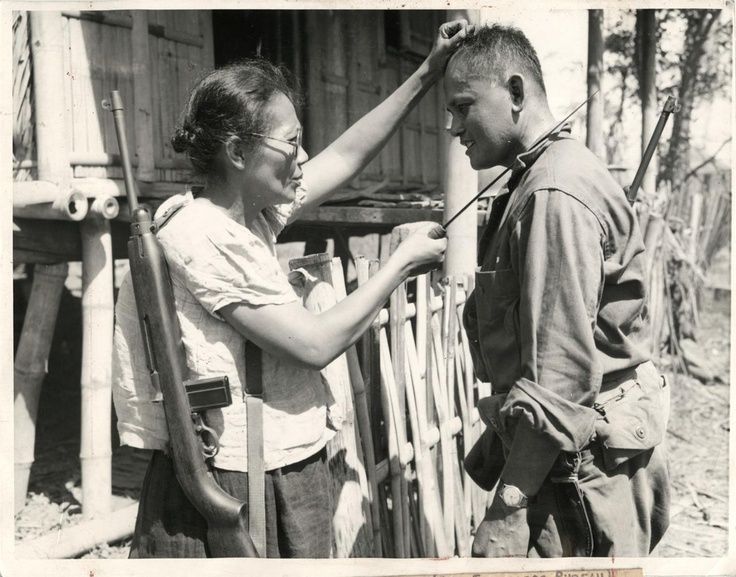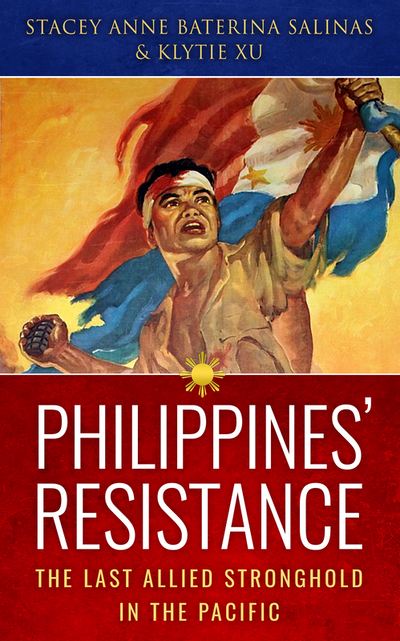- Home
- Stories
-
Internship
- Summer 2024 Internship
- Summer 2023 Internship
- Fall 2022 Internship
- Summer 2022 Internship
- Summer 2021 Internship
- Fall 2020- Spring 2021 Internship
- Summer 2020 Internship
- Fall 2019 Internship
- Summer 2019 Internship >
- School Year 2018-2019 Internship
- Summer 2018 Internship >
- Fall 2017 Internship
- Summer 2017 Internship >
- Books
- Archives
-
Resource Page
-
Supplementary Research Guides
>
- Unit 731 - Guide >
-
Philippines' Resistance - Guide
>
- Philippines World War II Timeline
- The Japanese Invasion & Conquest of the Philippines
- Bataan Death March
- Formation of Underground Philippines Resistance
- Supplies of the Guerrilla Fighters
- The Hukbalahap
- Hunter's ROTC
- Marking's Guerrillas
- United States Army Forces in the Philippines of Northern Luzon (USAFIP-NL)
- The Aetas
- Chinese and Filipino-Chinese Nationalist Guerrilla Units
- The Female Faces of the Philippine Guerrillas
- Rising Sun Flag - Guide >
- Pinay Guerrilleras - Guide >
- Fall of Singapore - Guide >
- Three Years and Eight Months - Guide >
- Siamese Sovereignty - Guide >
- The Khabarovsk War Crimes Trial - Guide >
- Unit 731 Cover-up : The Operation Paperclip of the East - Guide >
- Marutas of Unit 731 - Guide >
- Prince Konoe Memoir - Guide >
- Competing Empires in Burma - Guide >
- Battle of Shanghai - Guide >
- Ishi Shiro - Guide >
- Taiwan The Israel of the East - Guide >
- Seeking Justice for Biological Warfare Victims of Unit 731 - Guide >
- Rice and Revolution - Guide >
- Clash of Empires - Guide >
-
Hunger for Power and Self-SufficiencyI - Guide
>
- The Influence of War Rations on Post-War Culinary Transformations
- How World War II Complicated Food Scarcity and Invention
- American Military Innovations
- Government-Sponsored Food Inventions in Europe during World War II
- Feeding the Army: The Adaptation of Japanese Military Cuisine and Its Impact on the Philippines
- Mixed Dishes: Culinary Innovations Driven by Necessity and Food Scarcity
-
Denial A Quick Look of History of Comfort Women and Present Days’ Complication - Guide
>
- The Comfort Women System and the Fight for Recognition
- The Role of Activism and International Pressure
- The Controversy over Japanese History Textbooks
- The Sonyŏsang Statue and the Symbolism of Public Memorials
- Activism and Support from Japanese Citizens
- The Future of Comfort Women Memorials and Education
- Echoes of Empire: The Power of Japanese Propaganda - Guide >
- Lesson Plans >
-
Supplementary Research Guides
>
Female Faces in the Phillipine Guerrillas
Women, similar to the ethnic minorities who served as guerrillas throughout the war, are less well known for their military services during the war. Women’s history during World War II relates moreso to their participation and aid in relation to their roles in working in military based industries (i.e. Rosie the Riveter) on America’s domestic front or as nurses (in association with the Red Cross) as noted in common American histories of World War II. What makes the Underground Resistance so unique in the Philippines are the numerous accounts of female led insurgencies during the Japanese Occupation. Equal to men in both combat and strategy, these Filipina women broke gender conventions, organized guerrilla units in expansive territories/terrain, and conducted much of the spy and infiltration work to provide stable communication and supply networks in which the Underground Resistance used throughout the war.
Nieves Fernandez
|
Nieves Fernandez, a school teacher-turned-Huk commander from Leyte, showing an American soldier how to kill Japanese soldiers with a bolo (Photo by Stanley Troutman courtesy of reddit.com)
|
Nieves Fernandez is one of the lesser known Filipina guerrilla leaders. She is recorded by her peers and the local communities of Tacloban on the island of Leyte, as a simple Filipina school teacher who defended her homelands from the imperialist Japanese forces the moment her students were threatened to be taken away by Japanese soldiers. She was a skilled marksman and bolo fighter. Fernandez would gain the respect of native locals, lead men into battle, and was so successful in taking out Japanese patrols that the Japanese military stationed in the city, Tacloban, placed a 10,000 peso bounty on her head. Fernandez like many other guerrillas throughout the Philippines relied on makeshift weapons such as the “paltik” (a homemade shotgun made of gas pipes), bolos, homemade grenades (casings filled with old nails) and whatever items her 110 manned guerrilla unit could pilfer from the Japanese. Fernandez would live to be in her early nineties residing in Tacloban and would be survived by her sons and grandchildren. The only evidence of her heroics that survive remain in one photo (as displayed previously) and through a small 1944 American newspaper article depicting her guerrilla contributions prior to the arrival of MacArthur at Leyte.
Maria Rosa Henson
Maria Rosa Henson would represent and experience the worst of Japanese military atrocities inflicted upon Filipinas throughout the war. Henson’s experience as both a female guerrilla and comfort woman highlights the risks and ultimate vulnerabilities that women experienced in the Pacific under Japanese occupation. Women throughout the Pacific had heard the rumors and seen the atrocities exacted on Asian women by Japanese soldiers. Rape, abduction, mutilation, executions, and murder were daily threats that Filipina women faced. As a Filipino girl growing up during the war, simple tasks like getting water or picking up goods such as groceries for one’s family in the province, or small towns, came to be known as dangerous opportunities for women to be taken advantage of by Japanese soldiers.
Regardless of age, class, or occupation, Filipina women like other Asian women throughout the Japanese occupied Pacific were susceptible to sexual assaults. Henson, at the age of 15 was repeatedly raped by Japanese soldiers in her hometown Pasay prior to joining the Hukbalahap resistance. Enraged by the actions and invasion of her body and home by the Japanese Imperial Army, Henson would relay reconnaissance information for the Huks until her capture and arrest in 1943 in the suburbs of Angeles. As a captured guerrilla, her body was taken advantage of again by Japanese soldiers and she became a comfort woman. Even as a comfort woman, Henson would still try to help her Philippine people and when given the opportunity to speak with a local at one of the fences where she was imprisoned, was able to relay information to a Filipino villager of the oncoming Japanese encroachment and raids to the area.
Henson along with her accomplishments would continue to serve her country after the war and was one of the first Southeast Asian women to speak out about the Japanese abuse of the women they captured and molested throughout the Pacific Theater. Henson’s roles as a female guerrilla, comfort woman, and women’s activist further promote both the diversity and adversity the underground resistance encompassed and its lasting legacy on its promotion of civil liberties and humanitarianism long after the conclusion of the war.
Related Book
|
Philippines' Resistance:
The Last Allied Stronghold in the Pacific The people of the Philippine Islands during the early half of the 20th century experienced various waves of Western imperialism, two wars of attempted secession from Western powers, and two world wars. And yet the Philippine Islands and its people have received only small subheadings in many American textbooks and histories.
The wartime experiences from the perspectives of the Philippine people have gone unnoticed and have become overshadowed by the sociopolitical dominating legacy of American figures like General MacArthur, leader and historical symbol of the Pacific Theater during World War II. MacArthur's famous phrase "I came through and shall return" is etched into every facet of World War II historical narratives, textbooks, and monuments that pay tribute to the Allied forces in the retaking of the Pacific from the Japanese. But It is the lesser known people and leaders of the Philippine resistance against the Axis powers whose efforts and contributions allowed for the effective and speedy return of MacArthur's military forces. The Philippine guerrilla resistance consisted of a diverse cast of Filipino men and women, ethnic and indigenous minorities, American and European immigrants and soldiers, young and old, rich and poor, from farmer to politician. The various units of Philippine guerrillas, their tactics, military resources, and vigor to survive and end the Japanese maltreatment of the Philippine peoples paint the Pacific Theater from 1941-1945 as desperate, dark, and bloody for Asian communities throughout East and Southeast Asia. But their resourcefulness, cooperative efforts to collaborate and network with MacArthur across the South Pacific, and massive grassroots liberation movement directly point to the remarkable value that the Philippine Underground Resistance proved to be in aiding the Allies' ability to retake the Pacific |
|
Pacific Atrocities Education
730 Commercial Street San Francisco, CA 94108 415-988-9889 |
Copyright © 2021 Pacific Atrocities Education.
We are a registered 501 (c)(3) charity. |
- Home
- Stories
-
Internship
- Summer 2024 Internship
- Summer 2023 Internship
- Fall 2022 Internship
- Summer 2022 Internship
- Summer 2021 Internship
- Fall 2020- Spring 2021 Internship
- Summer 2020 Internship
- Fall 2019 Internship
- Summer 2019 Internship >
- School Year 2018-2019 Internship
- Summer 2018 Internship >
- Fall 2017 Internship
- Summer 2017 Internship >
- Books
- Archives
-
Resource Page
-
Supplementary Research Guides
>
- Unit 731 - Guide >
-
Philippines' Resistance - Guide
>
- Philippines World War II Timeline
- The Japanese Invasion & Conquest of the Philippines
- Bataan Death March
- Formation of Underground Philippines Resistance
- Supplies of the Guerrilla Fighters
- The Hukbalahap
- Hunter's ROTC
- Marking's Guerrillas
- United States Army Forces in the Philippines of Northern Luzon (USAFIP-NL)
- The Aetas
- Chinese and Filipino-Chinese Nationalist Guerrilla Units
- The Female Faces of the Philippine Guerrillas
- Rising Sun Flag - Guide >
- Pinay Guerrilleras - Guide >
- Fall of Singapore - Guide >
- Three Years and Eight Months - Guide >
- Siamese Sovereignty - Guide >
- The Khabarovsk War Crimes Trial - Guide >
- Unit 731 Cover-up : The Operation Paperclip of the East - Guide >
- Marutas of Unit 731 - Guide >
- Prince Konoe Memoir - Guide >
- Competing Empires in Burma - Guide >
- Battle of Shanghai - Guide >
- Ishi Shiro - Guide >
- Taiwan The Israel of the East - Guide >
- Seeking Justice for Biological Warfare Victims of Unit 731 - Guide >
- Rice and Revolution - Guide >
- Clash of Empires - Guide >
-
Hunger for Power and Self-SufficiencyI - Guide
>
- The Influence of War Rations on Post-War Culinary Transformations
- How World War II Complicated Food Scarcity and Invention
- American Military Innovations
- Government-Sponsored Food Inventions in Europe during World War II
- Feeding the Army: The Adaptation of Japanese Military Cuisine and Its Impact on the Philippines
- Mixed Dishes: Culinary Innovations Driven by Necessity and Food Scarcity
-
Denial A Quick Look of History of Comfort Women and Present Days’ Complication - Guide
>
- The Comfort Women System and the Fight for Recognition
- The Role of Activism and International Pressure
- The Controversy over Japanese History Textbooks
- The Sonyŏsang Statue and the Symbolism of Public Memorials
- Activism and Support from Japanese Citizens
- The Future of Comfort Women Memorials and Education
- Echoes of Empire: The Power of Japanese Propaganda - Guide >
- Lesson Plans >
-
Supplementary Research Guides
>

